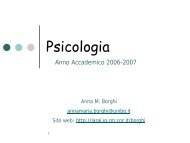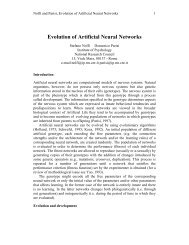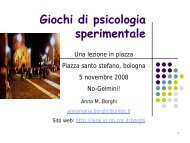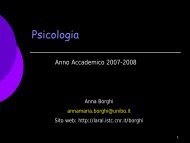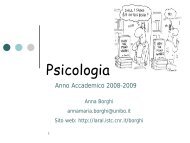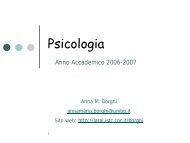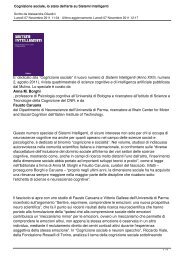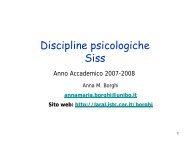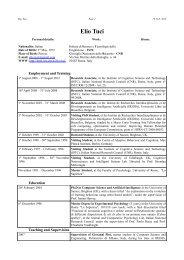Moving hands, moving entities. Annalisa Setti, Anna M ... - LARAL
Moving hands, moving entities. Annalisa Setti, Anna M ... - LARAL
Moving hands, moving entities. Annalisa Setti, Anna M ... - LARAL
Create successful ePaper yourself
Turn your PDF publications into a flip-book with our unique Google optimized e-Paper software.
The responses to animal targets were not modulated by the type of prime. We<br />
argue that this is due to the fact that animals are characterised by self-motion rather<br />
than the action one could perform on them. Even if animals can be grasped, (for<br />
example many have experienced grabbing a cat and taking it into his/her arms), they<br />
are mainly associated with their ability to move by themselves. Interestingly some<br />
brain regions responding to intentional actions (STS) (Saxe, Xiao, Perrett &<br />
Kanwisher, 2004) are also involved in perceiving objects as animate or inanimate<br />
(Schultz, Friston, O’Doherty, Wolpert, & Frith, 2005). In this line we argue that<br />
animals could be perceived more as acting agents than ‘passive’ objects of action.<br />
One could argue that the interference occurs due to a mismatch between the<br />
motion displayed in the prime and a word referring to a stationary object. However if<br />
this was the case one would expect a different interference effect from static and<br />
<strong>moving</strong> action primes, which does not occur. One would also expect an effect of<br />
facilitation on response times from <strong>moving</strong> primes (Motion only and Action+Motion)<br />
on ‘<strong>moving</strong>’ (animate) targets because they are characterised by motion, not such an<br />
effect has been found.<br />
In sum, the present study shows that (unimanual) grasping actions produced an<br />
interference effect on response to plant names. At a neural level, one could speculate<br />
that this interference effect could correspond to interactions in common cerebral<br />
circuitry, i.e. the mirror neuron system.<br />
Our results have different theoretical implications. First, in keeping with<br />
simulation theories of language comprehension they indicate that during word<br />
processing we are sensitive to the degree of animacy / self motion evoked by natural<br />
<strong>entities</strong>, i.e. plants and animals. To our knowledge, this is the first study that reveals<br />
that the simulation activated by words can be sensitive to this dimension. As animate<br />
18



